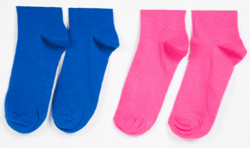
Educators everywhere have yet another new challenge—supporting children and their families from home. We know that high-quality interactions, including interesting, hands-on experiences that are facilitated and supported with feedback, scaffolding, and higher-order thinking questions, best support young students' learning. So, how do you offer your students' caregivers the same high-quality interactions while at home? Well, Rachel Giannini has some super fun ideas to share! The following are ideas she shared during her session at our recent InterAct CLASS Summit.
Use Labels to Help Create a Literacy-Rich Home
As many of us know, books are not a part of everyone's home. There are certain areas where libraries have been completely closed, and books are not always easily accessible, but we still want to have a literacy-rich environment. Labels are a really great way because it is so inexpensive!
You can scaffold this for your youngest kids all the way up to those emerging readers. You can start by using the labels to work on letter recognition, point out letter sounds, and begin word recognition.
But as those kids become older, you can:- Work on long or short vowels
- Find how many syllables are in that word
- Omit one of the letters within that label and have the child fill in the missing letter
- Find words around your house that rhyme
- Find letters that are not only in your name but in somebody else's name
And because those labels are so inexpensive, they can be changed over and over as your child becomes more and more confident with those skills.
Math with Socks
Children are concrete thinkers, so when we teach subjects like math, which is extremely abstract, we use manipulatives. And today we're gonna be using….socks!
With socks, you can do counting, pairing, and math equations. With manipulatives like socks, you can practice:

- One to one corresponding when counting up to ten (point to each sock while you count)
- Counting by twos
- Find pairs by identifying patterns
- Compare sizes and stack smallest to biggest
- Finding odds and even
And socks are also good for sensory needs like squeezing, throwing, and sock hockey!
Make the Most of Screen Time
Make the most of screen time! When watching a movie together, you can ask some of the same questions teachers ask during a read-aloud!
Before watching, ask them a few questions, like:
- How did you pick this?
- What do you think will happen?
Then, halfway through their watching, have them pause and ask:
- What has happened so far?
- What do you think will happen next?
Afterward, have them tell you their favorite character and why, and if they could change one thing, what would they change?
These questions seem super simple, and they are, but they help with sequencing, as well as critical thinking. You can use the same open-ended questions!
If you want more ideas to try at home, you can watch the entire session!
Rachel Gianinni is a childhood specialist, an early childhood advocate, and a video blog host. Rachel has an extreme enthusiasm for all things early childhood. She believes in the power of play, getting dirty, climbing trees, stargazing, pretending, and the idea that learning is magical. You can also check out all her videos on her website.
